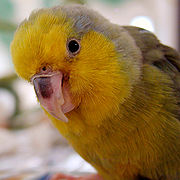
Yellow-faced Parrotlet
Encyclopedia
The Yellow-faced Parrotlet (Forpus xanthops) is a species of parrot
in the Psittacidae family.
It is endemic to dry woodland
, riparian thickets and scrub in the Marañón
Valley in northern Peru
.
It is treatened by habitat loss and trapping for the wild bird trade. The latter caused a rapid decline in the 1980s, but following a ban, the numbers appear to have stabilised, although at a very low number, with less than 1000 individuals remaining in the wild.

 The Yellow-faced Parrotlet is about 14.5 cm (6 in) long. It has a bright yellow face and brown irises. The upper parts are olive-grey and the lower parts are greenish-yellow. The back of the head and neck are bluish and a bluish strip extends forward towards each eye. Its beak is mainly horn coloured and the upper mandible has a greyish base. The legs are pinkish-brown. The lower back and rump are dark blue in the male and light blue in the female. The juveniles are duller with less yellow on the face and their beaks are horn coloured all over.
The Yellow-faced Parrotlet is about 14.5 cm (6 in) long. It has a bright yellow face and brown irises. The upper parts are olive-grey and the lower parts are greenish-yellow. The back of the head and neck are bluish and a bluish strip extends forward towards each eye. Its beak is mainly horn coloured and the upper mandible has a greyish base. The legs are pinkish-brown. The lower back and rump are dark blue in the male and light blue in the female. The juveniles are duller with less yellow on the face and their beaks are horn coloured all over.
Parrot
Parrots, also known as psittacines , are birds of the roughly 372 species in 86 genera that make up the order Psittaciformes, found in most tropical and subtropical regions. The order is subdivided into three families: the Psittacidae , the Cacatuidae and the Strigopidae...
in the Psittacidae family.
It is endemic to dry woodland
Woodland
Ecologically, a woodland is a low-density forest forming open habitats with plenty of sunlight and limited shade. Woodlands may support an understory of shrubs and herbaceous plants including grasses. Woodland may form a transition to shrubland under drier conditions or during early stages of...
, riparian thickets and scrub in the Marañón
Marañón River
The Marañón River rises about 160 km to the northeast of Lima, Peru, flows through a deeply-eroded Andean valley in a northwesterly direction, along the eastern base of the Cordillera of the Andes, as far as 5 degrees 36' southern latitude; then it makes a great bend to the northeast, and...
Valley in northern Peru
Peru
Peru , officially the Republic of Peru , is a country in western South America. It is bordered on the north by Ecuador and Colombia, on the east by Brazil, on the southeast by Bolivia, on the south by Chile, and on the west by the Pacific Ocean....
.
It is treatened by habitat loss and trapping for the wild bird trade. The latter caused a rapid decline in the 1980s, but following a ban, the numbers appear to have stabilised, although at a very low number, with less than 1000 individuals remaining in the wild.
Description


External links
- World Parrot Trust Parrot Encyclopedia - Species Profile
- Photo-High Res; Article tropicalbirding–"Northern and Central Peru"

